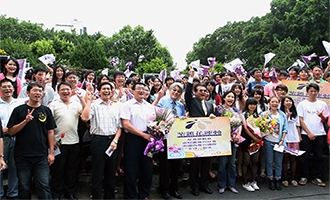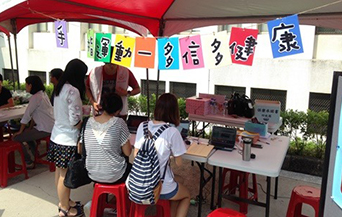Health Education(HE)
A. About Health Education
Performance Goal
- Advocate health-related education such as health care projects and disease prevention regularly. Record and evaluate the teaching performance.
Primary Job Content
- Monitor special condition students by constructing student learning profiles.
- Organize health and safety related courses and activities.
- Develop health promotion projects.
- Push forward the “Chun-Hui” program and advocate anti-drug and anti-AIDS.



B. Health Education Features
Framework
- Utilize the general education under the course curriculum to implement the health education teaching projects.
- Utilize school promotions and events under the extra- curriculum activities to reinforce the accident prevention projects.
Policy & Regulations
- Implement projects in compliance with the School Health Act, Gender Equity Education Act, and Sexual Assault Prevention Act announced by the Ministry of Education.
- Develop health promotion projects specifically against demands of different subjects.
- Stipulate smoke-free policies for public campus areas.
Programs
- Implement the "Chun-Hui" program to reinforce the anti-drug and anti-AIDS education projects.
- Organize "Traffic Safety Month" events every semester.
- Execute violence prevention, fire drill and water activity safety programs.
- Inspect and monitor the food sanitation on campus.
Documents
- Study student learning profiles in order to understand and keep track of their learning progress.
- Record the execution process and results of each health promotion project.
Evaluation
- Conduct questionnaire survey and analysis at the beginning and the end of semester to find out the improvement of campus atmosphere.
- Conducted performance evaluation for the content of health education.
- Evaluate the execution performance via course learning sheets and teaching evaluations.
Sharing
- Organize regular safe school promotion group meeting.
- Host seminars and trainings on environmental safety issues and invite experts for speech.
- Participate in health and safety education seminars to exchange and share experiences.
C. Creative safety teaching plan: Third-level student depression and self-destruction prevention project
Project background
The World Health Organization has listed depression as the major preventive disease of the 21 century. According to the statistic data announced by the WHO, there are approximately 1.21 billion people affected by depression and around 15% of them died of suicide. Most patients who died of suicide ended their lives at very early ages. In school, university students are faced with increasing societal changes and pressures. Students usually suffer from symptoms such as emotional disturbances and depression or even self-destruction behavior when they have difficulties adapting to life.
The effect of depression, however, can be reduced through early diagnosis and early treatment. If the development of depression can be prevented early, not only will it reduce the percentage of suicide but also the expenditure of social costs. School is a primary location where students spend most of their time; therefore, the authority should aggressively assist the development of physical and mental health in teachers and students and reinforce the prevention of depression and self-destruction in students. This project is developed to effectively reduce the prevalence of depression and self-destruction.
Expected objectives
- Conduct screenings for students in needs of excessive attention. Put together a personal profile and keep track regularly in order to reduce self-destruction incidents on campus.
- Establish a crisis response standard operation procedure for handling depression and self-destructive students.
- Integrate online resources for the prevention of depression and self-destruction. Work in collaboration to facilitate the prevention of depression and self-destruction in students.
- Establish and reinforce the tertiary prevention task model for depression and self-destruction in students.
Content of projects
- Preliminary prevention:
- Objective: enhance the mental health of students to prevent self inflicted injuries caused by depression.
- Strategy: increase protection factors and reduce risk factors.
- Action plan: lay down a campus crisis response mechanism. Establish a 24-hr assistance hotline. Conduct routine drills based on the suicide response standard operation procedure.
- Secondary prevention:
- Objective: early identification and intervention to reduce the potential of occurrence or progression of self-destruction due to depression.
- Strategy: screen for high risk groups to provide immediate intervention.
- Action plans:
- Screen for students in need of excessive attention: Questionnaire surveys are conducted every semester to screen for students in need of excessive attention.
- Inclusive follow-up and counseling: Profiles for students in need to excessive attention are complied based on the screening data. Long-term follow-up and intervened counseling should be enforced regularly every semester. Proceed to crisis control when necessary.
- Improve the ability to identify depression for teachers, military instructors, peers, employees, and parents in order to assist the identification and screening. Provide transfer resources, personal or group therapies and treatments to the identified high risk group.
- Integrate professional resources from outside the school (ex: clinical psychologists, counseling psychologists, social workers, psychiatrists) to provide on-campus service.
- Tertiary prevention:
- Objective: prevent suicide attempters and friends and relatives of suicide victims to imitate suicide.
- Strategy: establish a crisis response and control standard operation procedure for suicide incidents or suicide attempts.
- Action plans:
- Suicide attempts: Establish a crisis response standard operation procedure for individual cases. Announce the guidelines and provide education guidance in school (to reduce the suicide imitation effect). Pay attention to whether the other attention demanding groups are affected as well. Arrange subsequent mental therapy with a psychologist for each individual patient to prevent further attempts. Contact the parents and provide suicide prevention education.
- Suicide victims: Establish a control standard operation procedure which includes the official announcement to the press, public announcement and education guidance to school units (to reduce the suicide imitation effect), notification of parents and grief therapy.
- Notification and Transfer: Report and transfer suicide cases in compliance with the campus safety and crisis report guidance and the “Suicide Prevention Report and Transfer Operation Procedure” announced by the Department of Health, Executive Yuan.
Evaluation
- Performance inspection: Based on the regulations of the Ministry of Education, the performance evaluation for depression and self-destruction prevention will be completed and submitted to the authorities for audit within 1 month after the semester is over.
- Facilitate the supervision of incident notification and crisis control.
Relevant activities
- Peer Care Events (2006/11/20, 21, 27)
Improved the understanding of depression and bipolar disorder among students to encourage them to help others, care for the society, and develop a sympathetic attitude. Establish a comprehensive peer care-taking system in hopes to achieve the goal of preliminary prevention. Five events including "Re-birth from Depression", "Prize Winning Q&A Activity", "Dance with the Soul-Bipolar Disorder Book Reading Seminar", "Christmas Red, Snowflake White, No More Depression—Sending Love with a Card" were organized and a total of 2,728 students participated. - Happiness Creation Hut—Creative Humor and Pressure Adjustment Seminar (2007/11/6)
The seminar was hosted at the Chueh-sheng International Conference Hall and the content of which included two sessions of plenary speeches and practical seminars each. Cases of pressure adjustment were shared and discussed during the seminar. 660 students attended and the overall satisfactory rate was 92%. The current status of humor and creative training courses were analyzed in the seminar. Consultation and counseling staffs were trained to utilize their humor and creativity during their practice through the seminars and trainings. Participants learned the effect of humor and creativity in relieving emotions and pressures through others sharing their own creativity and happiness experiences, which also enabled them to help students create a more positive meaning of life. - Group Counseling and Psychological Workshop (organized randomly every semester)
Twenty four groups and workshops were organized in 2006 and 2007. Eight physical and mental relaxation groups for students and staffs were established including interpersonal relationship growth group, couples communication workshop and more. The overall participation rate is around 95%. - Suntan Together—Peer Guidance Workshop (2008/5/17-18)
Enhanced the sense of revolution and friendship among students and inspired them to help others and themselves through camp events. Such inspiration will also affect other students.


